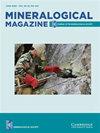Physical properties and crystal structure of near end-member oxy-dravite from the Beluga occurrence, Nunavut territory, Canada
IF 1.4
3区 地球科学
Q2 MINERALOGY
引用次数: 0
Abstract
Abstract Oxy-dravite, ideally Na(Al2Mg)(Al5Mg)(Si6O18)(BO3)3(OH)3(O), was found in a composition near its ideal end-member at the Beluga occurrence, Nunavut territory, Canada. It occurs in retrograde albite–muscovite–corundum–calcite domains in a calc-silicate rock. This uncommon oxy-dravite occurs as dark brown, equant to short-prismatic, idiomorphic crystals with vitreous lustre and up to ca. 4 × 3 cm in size. The oxy-dravite is optically uniaxial (–), with ω = 1.6453(5) and ɛ = 1.6074(18); its calculated density is 3.069 g.cm–3 with a compatibility index of 0.016. The Beluga oxy-dravite has trigonal symmetry, space group R3m with a = 15.9121(2) Å, c = 7.1788(10) Å, V = 1574.12(5) Å3 and Z = 3. The crystal structure was refined to R1 = 1.45 using 1613 unique reflections. The empirical crystal-chemical formula is X(Na0.88Ca0.08□0.03K0.01)Y(Al1.49Mg1.31Fe0.15Ti0.04Zn0.01)Z(Al5.42Mg0.58)T(Si5.84Al0.16O18)B(BO3)3V(OH2.95O0.05)W(O0.84OH0.01F0.15). Oxy-dravite in nature commonly occurs in a solid solution with foitite, schorl and oxy-schorl. At the Beluga occurrence, its minor contents of Al, vacancy [□], and Ca are most likely compensated by (□Al)(NaR2+)–1 and (CaMg)(NaAl)–1 exchanges of the oxy-magnesio-foitite and magnesio-lucchesiite components. The Beluga occurrence of oxy-dravite is characterised by an Mg-rich environment related to a metamorphic overprint of the original sedimentary sequence. This sequence of marine dolomitic argillaceous marl was influenced by (B,Cl)-rich fluids, probably proximally-derived from mineral breakdown reactions in the calc-silicate during the retrograde stage of metamorphism. The locality is a rare example of a tourmaline + corundum assemblage.加拿大Nunavut地区Beluga产状近端元氧生辉石的物理性质和晶体结构
本文章由计算机程序翻译,如有差异,请以英文原文为准。
求助全文
约1分钟内获得全文
求助全文
来源期刊

Mineralogical Magazine
地学-矿物学
CiteScore
4.00
自引率
25.90%
发文量
104
审稿时长
6-12 weeks
期刊介绍:
Mineralogical Magazine is an international journal of mineral sciences which covers the fields of mineralogy, crystallography, geochemistry, petrology, environmental geology and economic geology. The journal has been published continuously since the founding of the Mineralogical Society of Great Britain and Ireland in 1876 and is a leading journal in its field.
 求助内容:
求助内容: 应助结果提醒方式:
应助结果提醒方式:


